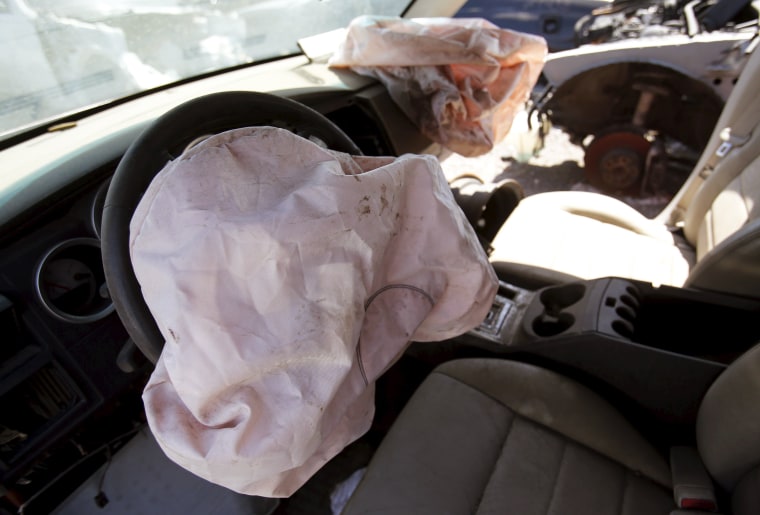After setting a new record for automobile recalls in 2015, the new year is off to a questionable start, with federal regulators ordering repairs for millions more vehicles equipped with potentially defective Takata air bags.
Last week’s announcement by the National Highway Traffic Safety Administration came at a time when automakers and automotive regulators alike are trying to change the way they address vehicle safety.
A new industry-government consortium is aimed at bringing advanced technology to market faster than would be possible through traditional rule-making. But at the same time, Congress has approved a tripling of the potential penalties for violating safety regulations.
“NHTSA stands ready to use all its tools to address public safety,” stressed Mark Rosekind, the NHTSA administrator, during a speech to industry leaders in Detroit earlier this month. But he added that the goal is not to use the “stick” unless absolutely necessary.
As Driving Declines, Automakers Look to Climb Aboard Sharing Economy
Automotive safety has been in the headlines a lot in recent years. And NHTSA has swung that stick more than few times, levying hefty fines against the likes of BMW, Honda, General Motors and Toyota, among other automakers.
It’s because of the threat of sanctions – which jump to $105 million per safety violation under the new U.S. transportation bill – that the number of recalls has been rising, according to experts like Clarence Ditlow, director of the Center for Auto Safety in Washington, D.C.
He said the steeper penalties will "put new pressure" on car companies to take quick action on safety problems that matters they might have ignored in years past or, in some cases, which would have been addressed on a one-by-one basis when owners complained.
Other factors have contributed to the surge in recalls, though. In an effort to improve their economies of scale, manufacturers frequently share components, rather than designing unique widgets for individual brands and models. So, a defect that might have once led to a recall covering thousands of vehicles might today involve hundreds of thousands, even millions.
Ford Pulls Out of Japan and Indonesia, Blaming Market Conditions
Nowhere is that more apparent than with Takata, the Japanese supplier whose air bags can inflate with explosive force in collisions, spraying shrapnel into the passenger compartment. A tenth death linked to the problem was announced last week.
That was accompanied by yet another recall, this one involving about 5 million air bag inflators. Since many vehicles use more than one of the suspect devices, NHTSA has not yet come up with the precise number of cars, trucks and crossovers that will be recalled. But prior to the latest move, more than 19 million vehicles using Takata components were on the list. And Rosekind has hinted still more could follow.
A total of 51.5 million vehicles were recalled in 2015, a slight increase from the record set in 2014. Few experts are willing to say there won’t be yet another new high this year as automakers are pressed to adopt a zero-tolerance approach.
But the automakers aren’t the only ones having to reform their safety practices. NHTSA itself came under heavy fire during a series of congressional hearings last year. Lawmakers faulted the agency for failing to catch problems such as the Takata airbag defect, as well as the General Motors ignition switch issue. It took GM a decade to order a recall, and by then more than 120 people had died.
“The pieces are in place to make proactive safety the real story.”
For his part, Rosekind has ordered NHTSA to take dozens of steps to become more responsive to safety issues. Among other things, it hopes to use owner complaints to help track problems down faster than ever.
The new transportation bill, while falling short of what the White House asked for, should provide some additional funding for the agency.
“The pieces are in place to make proactive safety the real story,” said Rosekind.
The new consortium announced during the North American International Auto Show in Detroit could set the shift in motion. In all, 18 manufacturers, including Toyota, VW, Ford, Nissan, BMW, Tesla and GM, have signed on.
“We can do a lot and learn from other industries,” said GM Chairman and CEO Mary Barra, noting that a similar approach in the airline industry has led to a significant reduction in fatal crashes over the last decade.
NHTSA – along with several automakers – has set a goal of reaching zero fatalities in the years ahead. If that really is possible and, if so, how soon, is far from clear. If anything, preliminary data suggest highway deaths actually rose in 2015 after hitting a historic low the year before.
Regulators and the regulated alike are feeling pressure to prevent problems like the Takata and GM fiascos from happening again, said Dave Cole, director-emeritus of the Center for Automotive Research, in Ann Arbor, Michigan.
Ironically, that could result in a further rise in recall numbers as even the smallest safety issues are called out for repairs. But the long-term payoff could result in far fewer crashes and fewer deaths.
More From The Detroit Bureau
Jeep Planning to Build Its First Pickup in Decades
